Family : Antennariidae

Text © Giuseppe Mazza

English translation by Mario Beltramini
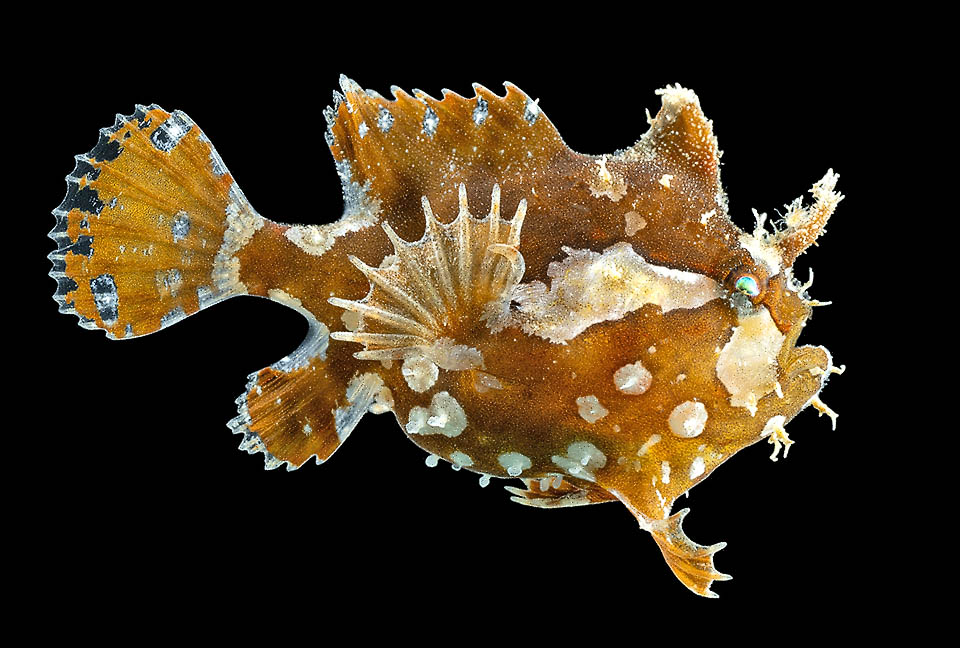
The Sargassum harlequin (Histrio histrio) has a very vast range, almost cosmopolitan at temperatures between 21,4 and 29,2 °C © Viktor Peinemann
Known as Sargassum harlequin, Histrio histrio (Linnaeus 1758) belongs to the class of the Actinopterygii, the ray-finned fish and to the order of the Lophiiformes and to the family of the Antennariidae, that of the frogfishes.
They are animals that were hunting already at the beginning of the Tertiary with a strange fishing line on the head to arouse the curiosity of the prey and then to swallow them in one gulp. Fishes present in all seas today, up to more than 1000 m in depth, with dimensions going from 3 cm to 2 m for the Fishing frog (Lophius piscatorius) that due to the size and the goodness of its flesh has given the name to the order.
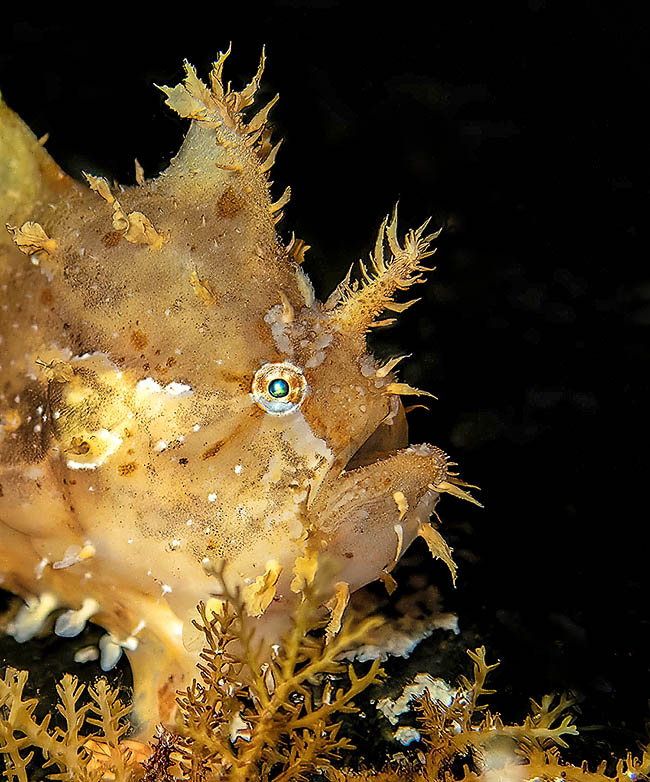
The first ray of the dorsal has transformed in a fishing line with bait, the illicium, to intrigue and attract the preys © Jean Marie Gradot
Masters of camouflage, like Antennarius commerson that perfectly imitates the sponges of the environment where it lives, and our Sargassum harlequin who moves drifting hidden among the floating plants amply deserving the tautonym Histrio histrio, from the Latin “histrionicus”, related to the actors, not only for the movements of the fishing line and the surprising shape of the body, but also for the changing livery with colours and drawings changing instantly due to effect of the chromatophores.
Zoogeography
The Sargassum harlequin has a very vast range in western Atlantic from Canada up to the estuary of the Rio de la Plata in Uruguay.
In the eastern Atlantic it is found from the Açores to offshore western Africa drifting at times with the Gulf Current up to Norway.
In the Indian Ocean it is present from South Africa to the Red Sea, Madagascar, Réunion and Mauritius, up to the eastern coasts of India and of Sri Lanka.
Its presence in the eastern Pacific is to be confirmed, but in western Pacific reaches Australia, Taiwan, Pilipinas, Moluccas, Papua New Guinea, Guam, Tonga, New Caledonia and New Zealand up to the Mariana Islands in Micronesia.
Ecology-Habitat
Histrio histrio is an oceanodromous species that goes down up to 50 metres in depth, but usually is found in the first 2 m at temperatures between 21,4 and 29,2 °C, and survives for a long time even out of water, on the floating seaweeds where at times it gets shelter in order to escape from the attack of the fishes.
Morphophysiology
The Sargassum harlequin can reach a length of 20 cm. The body, stocky and globose, scaleless, is covered by protuberances similar to seaweeds.
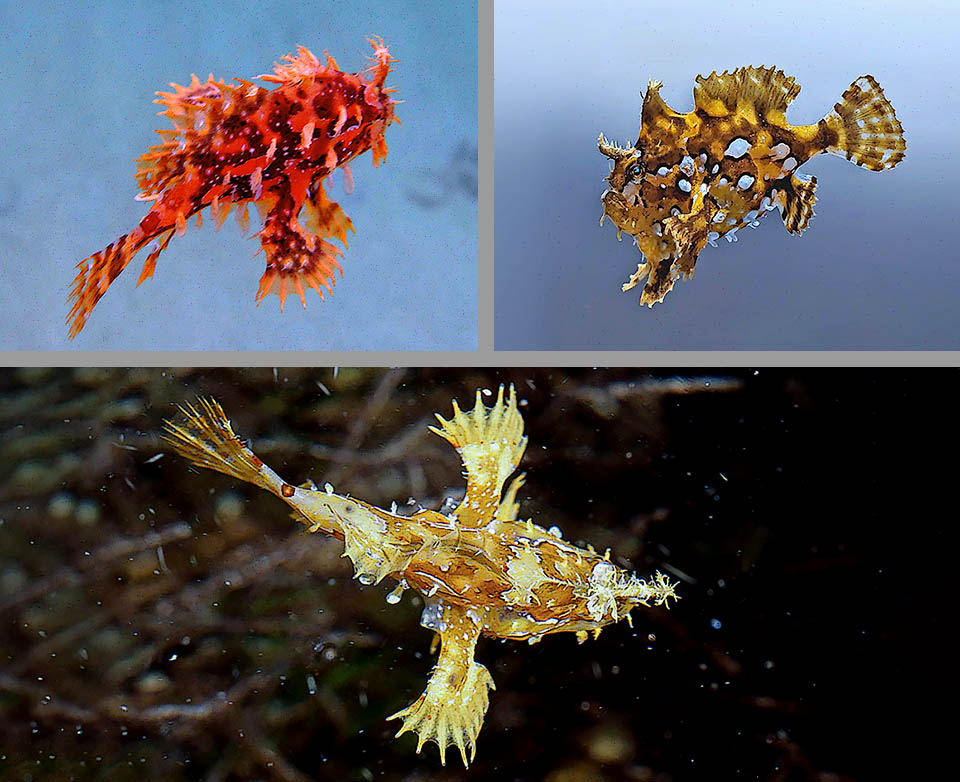
The pectoral and pelvic fins are used as limbs to cling to the floating plants and the livery may change instantly in colour. From top, clockwise, © Ryne Rutherford © Jess and © Francisco Herrera
The pectoral fins, used as hands to attach itself and move among the floating plants, are pedunculate with 9-11 rays and to lean it rely also on its large pelvic fins. The dorsal fin has 3 spines, with the fire one transformed in illicium long less than half the second, and 11-13 soft rays. The anal displays 7-13 unarmed rays and the central rays of the caudal are bifurcated.
The mouth is wide, armed by many small villiform teeth, and can expand in a fraction of second, to suck in with a snap ahead prey even bigger, expelling violently the water from the gill openings.
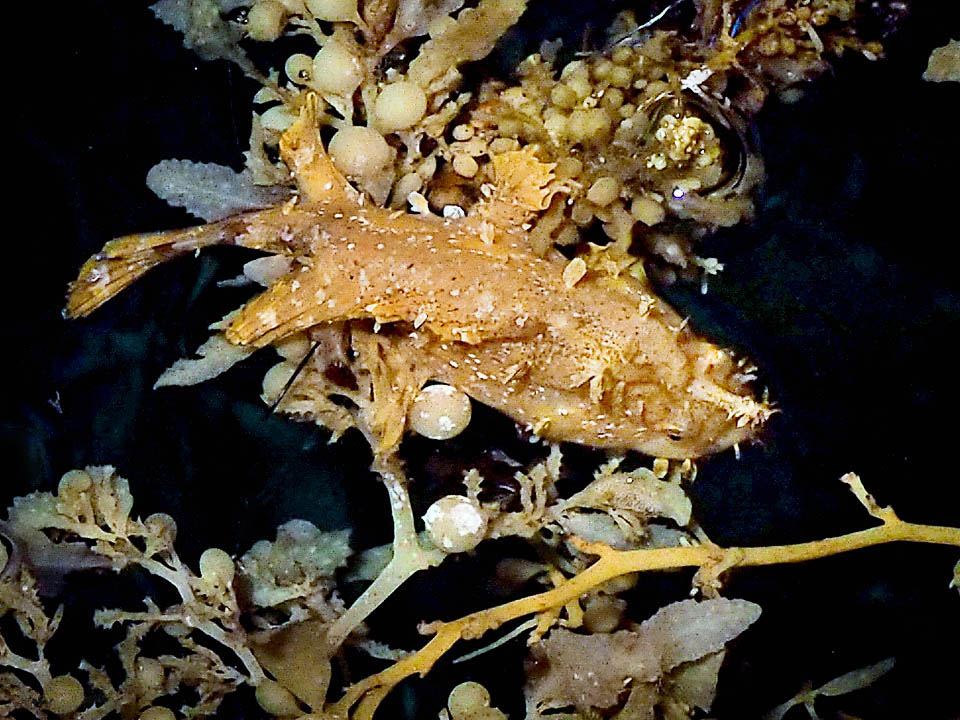
Difficult for unlucky passers-by to understand that it’s a fish, when it looks at them motionless camouflaged among sargassos. The mouth may open instantly with a leap forward expelling violently the water from gill openings, and even bigger preys get into the darkness of its stomach expandable almost with no limits © Susanne Spindler
Especially in the juveniles we note at the extremity of the tail a submarginal bar formed by black small dots, present also bigger and spaced, with various colours or white, over the rest of the body.
Ethology-Reproductive Biology
Histrio histrio is a voracious fish and shrimp hunter, and an unscrupulous cannibal who does not hesitate in swallowing its own young. It is an oviparous dioecious species, that is with separate sexes, and the reproduction occurs almost all the year round.
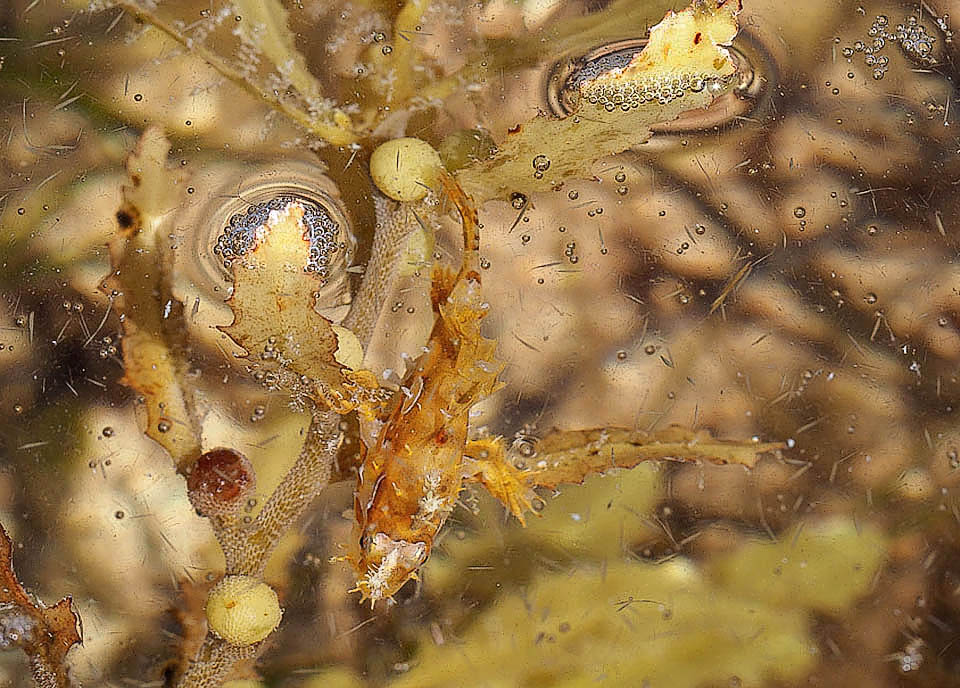
Eggs are laid and fecundated one close to the other, in a floating raft that sticks to the vegetation © Francisco Herrera
Due to the poor mobility of the species, for a male it is not easy to find a partner and when this occurs it follows her until when she is ready to spawn.
The eggs, merged in a gelatinous mass, form an unusual floating raft where the fecundation takes place. This small vessel ends sooner or later stuck to the plants with its load and the eggs thus keep merged until hatching. The larvae, that measure about 2 mm, are found even at a depth of 600 m. They are protected by a spherical structure that wraps the body, wit openings for the mouth, the anus and the fins, and when about 9 mm, this involucre merges with the epidermis, we can talk about little fishes.
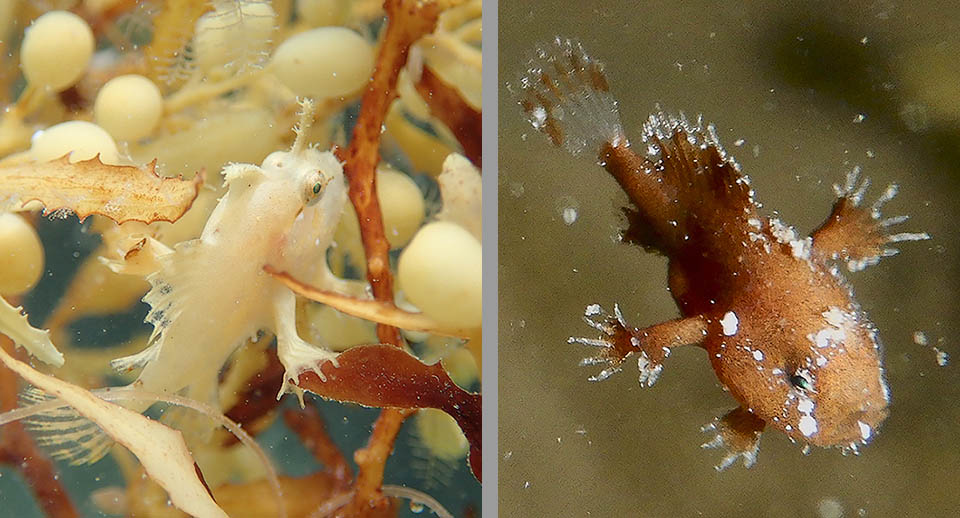
The larvae measure about 2 mm and are protected by a spherical structure with orifices letting the fins, mouth and anus out. When this involucre merges with epidermis, about 9 mm of size, we can talk of little fishes. The young shown here have already the illicium and look a lot like their parents their parents © Ben Eddy (left) and © lillianclementine (right)
The resilience of the Sargassum harlequin is high, with a minimum time for doubling the populations lesser than 15 months and even is it is preyed upon by bigger fishes and marine birds who survey the surface, the fishing vulnerability, very low, marks only 10 on a scale of 100. Apart from a few withdrawals from the aquaria, in fact it is not hunted by man, also because its flesh may be toxic, at ciguatera risk, when its nourishes of fishes storing in their diet the toxin produced by the Gambierdiscus toxicus.
In some sites it is threatened by the pollution, but in the whole the populations are stable and from 2013 Histrio histrio appears therefore as “LC, Least Concern“, in the IUCN Red List of the endangered species.
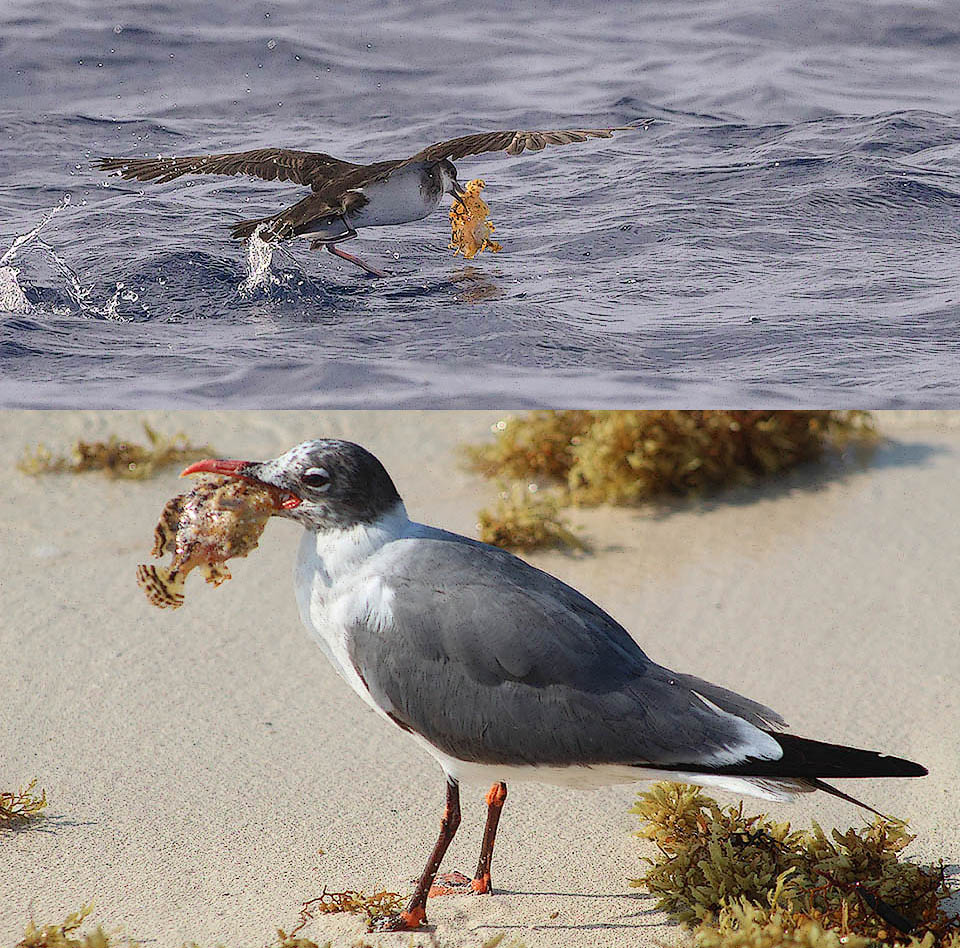
Some moving on surface and sheltering even out of water on the floating seaweeds carpets to escape the fishes voracity, often end up into the seagulls mouths but populations are stable and the Sargassum harlequin is presently considered as not endangered species © Stephen John Davies (above) © Alejandra Flores (below)
Synonyms
Lophius histrio Linnaeus, 1758; Antennarius histrio (Linnaeus, 1758); Chironectes histrio (Linnaeus, 1758); Pterophrynoides histrio (Linnaeus, 1758); Lophius tumidus Osbeck, 1765; Chironectes tumidus (Osbeck, 1765); Pterophryne tumida (Osbeck, 1765); Lophius histrio marmoratus Bloch & Schneider, 1801; Lophius laevis Latreille, 1804; Lophius raninus Tilesius, 1809; Antennarius raninus (Tilesius, 1809); Cheironectes raninus (Tilesius, 1809); Histrio raninus (Tilesius, 1809); Pterophryne ranina (Tilesius, 1809); Lophius cocinsinensis Shaw, 1812; Chironectes variegatus Rafinesque, 1814; Pterophryne variegatus (Rafinesque, 1814); Lophius gibbus Mitchill, 1815; Antennarius gibbus (Mitchill, 1815).
→ For general information about FISH please click here.
→ For general information about BONY FISH please click here
→ For general information about CARTILAGINOUS FISH please click here.
→ To appreciate the BIODIVERSITY of BONY FISH please click here.
→ To appreciate the BIODIVERSITY of CARTILAGINOUS FISH please click here.
